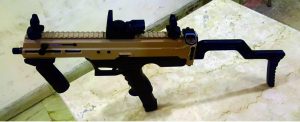The Indian Ministry of Defense (MoD) announced that the Indian Army and the Defense Research and Development Organization (DRDO) have jointly developed India’s first indigenous 9 mm machine pistol. An MoD statement released on January 14 noted, “Infantry School, Mhow and DRDO’s Armament Research & Development Establishment (ARDE), Pune have designed and developed this weapon using their respective expertise in the complementary areas.”
Describing the development of “Asmi” – as the new personal defense weapon has been christened – the MoD said: “The weapon has been developed in a record time of four months. The Machine Pistol fires the in-service 9mm ammunition and sports an upper receiver made from aircraft grade Aluminium and lower receiver from carbon fibre.”
A “3D Printing process has been used in designing and prototyping of various parts including trigger components made by metal 3D printing,” it added.
The weapon has been modelled after the legendary Israeli Uzi submachine gun. LiveMint quoted a statement from the DRDO as saying: “The machine pistol can fire at a range of 100 metres and is in the class of the Uzi series guns of Israel. The prototype has fired over 300 rounds in the last four months of its development.”
According to the MoD, the Asmi’s per unit production cost is 50,000 Indian rupees ($684) and its development follows Indian Prime Minister Narendra Modi’s call for self-reliance and indigenous manufacturing, including in defense.
While the MoD statement notes “it is expected that the Services and Paramilitary Forces (PMFs) will induct this [Asmi] expeditiously,” when it comes to indigenous weapons and platforms being inducted into the Indian armed forces, matters are easier said than done.
In the recent years, India’s dependence on foreign weapons has come under close scrutiny, both inside the government and within the Indian strategic community. However, despite episodic pushes, the Indian government has found the armed forces reluctant to adopt domestically manufactured weapons and platforms — even as it has struggled to get defense manufacturing off the ground in the first place.
The Indian army has long sought to replace the aging indigenously produced INSAS assault rifle with a better infantry rifle. A 2018 India-Russia agreement to manufacture AK-203 assault rifles, which would have replaced the INSAS weapons, in India under license continues to languish. Instead, India ordered an additional 72,500 SIG Sauer 716 rifles from the United States amid the Ladakh standoff, having imported a similar number of those rifles for counterterrorism operations in 2019.
But, since the beginning of Modi’s self-reliance push, there are modest indications that India is getting serious about inducting indigenously developed weapons and platforms into the armed forces. On January 13, in a move hailed by many as a signal development, the Indian Cabinet Committee on Security cleared the way for the Indian Air Force to acquire 83 Tejas light combat aircraft – designed by DRDO and manufactured by Hindustan Aeronautics Limited – at a cost of 480 billion Indian rupees ($6.5 billion). Defense Minister Rajnath Singh described the decision on Twitter as the “largest indigenous defence procurement deal” and a “game changer for self-reliance in the Indian defence manufacturing.”
But whether the Asmi machine pistol will remain anything more than a prototype remains to be seen.

































